
Sir John Major is a British former politician who served as Prime Minister of the United Kingdom and Leader of the Conservative Party from 1990 to 1997. He previously held Cabinet positions under prime minister Margaret Thatcher, his last as chancellor of the Exchequer from 1989 to 1990. Major was Member of Parliament (MP) for Huntingdon, formerly Huntingdonshire, from 1979 to 2001. Since stepping down as an MP in 2001, Major has focused on writing and his business, sporting and charity work, and has occasionally commented on political developments in the role of an elder statesman.

Margaret Hilda Thatcher, Baroness Thatcher, was a British stateswoman and Conservative politician who served as Prime Minister of the United Kingdom from 1979 to 1990 and Leader of the Conservative Party from 1975 to 1990. She was the longest-serving British prime minister of the 20th century and the first woman to hold the position. As prime minister, she implemented economic policies known as Thatcherism. A Soviet journalist dubbed her the "Iron Lady", a nickname that became associated with her uncompromising politics and leadership style.

The prime minister of the United Kingdom is the head of government of the United Kingdom. The prime minister advises the sovereign on the exercise of much of the royal prerogative, chairs the Cabinet and selects its ministers. As modern prime ministers hold office by virtue of their ability to command the confidence of the House of Commons, they sit as members of Parliament. The current prime minister is Rishi Sunak of the Conservative Party, who assumed the office on 25 October 2022.

Downing Street is a street in Westminster in London that houses the official residences and offices of the Prime Minister of the United Kingdom and the Chancellor of the Exchequer. In a cul-de-sac situated off Whitehall, it is 200 metres (660 ft) long, and a few minutes' walk from the Houses of Parliament. Downing Street was built in the 1680s by Sir George Downing.
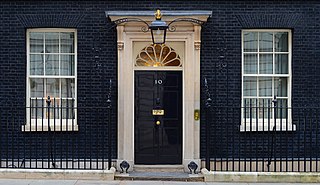
10 Downing Street in London is the official residence and office of the Prime Minister of the United Kingdom.
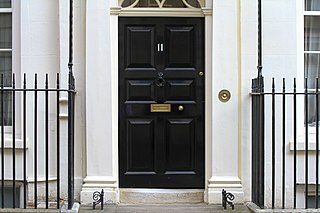
11 Downing Street in London, also known colloquially in the United Kingdom as Number 11, is the official residence of the Chancellor of the Exchequer. The residence, in Downing Street in London, was built alongside the official residence of the Prime Minister at Number 10 in 1682.

The Birmingham Botanical Gardens are a 15-acre (6-hectare) botanical garden situated in Edgbaston, Birmingham, England. The gardens are located 1+1⁄2 miles (2.4 km) south-west of Birmingham city centre at grid reference SP049854. Designed in 1829, the gardens are Grade II* listed in Historic Englands's Register of Parks and Gardens, and retain many original features and layout, which was designed by the landscape gardener and horticulturalist John Claudius Loudon. The site is notable for its range of glasshouses and gardens, which display a wide variety of plants and birds. Birmingham Botanical Gardens is managed by Birmingham Botanical and Horticultural Society, a registered charity. The gardens are open daily to the public with paid admission.
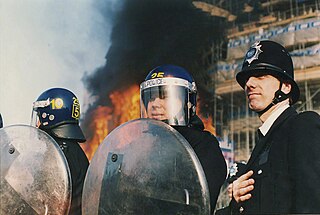
The poll tax riots were a series of riots in British towns and cities during protests against the Community Charge, introduced by the Conservative government of Prime Minister Margaret Thatcher. The largest protest occurred in central London on Saturday 31 March 1990, shortly before the tax was due to come into force in England and Wales.

The office of Downing Street Chief of Staff is the most senior political appointee in the Office of the Prime Minister of the United Kingdom, acting as a senior aide to the Prime Minister of the United Kingdom. The holder of the office retains a highly powerful, non-ministerial position within His Majesty's Government.

The modern political history of the United Kingdom (1979–present) began when Margaret Thatcher gained power in 1979, giving rise to 18 years of Conservative government. Victory in the Falklands War (1982) and the government's strong opposition to trade unions helped lead the Conservative Party to another three terms in government. Thatcher initially pursued monetarist policies and went on to privatise many of Britain's nationalised companies such as British Telecom, British Gas Corporation, British Airways and British Steel Corporation. She kept the National Health Service. The controversial "poll tax" to fund local government was unpopular, and the Conservatives removed Thatcher as Prime Minister in 1990, although Michael Heseltine, the minister who did much to undermine her, did not personally benefit from her being ousted.
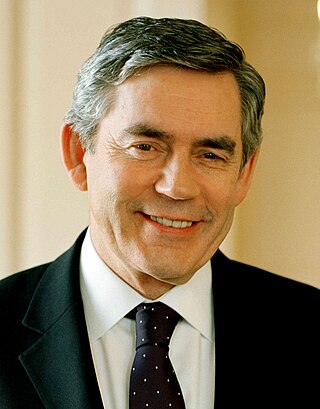
Gordon Brown's term as the prime minister of the United Kingdom began on 27 June 2007 when he accepted an invitation of Queen Elizabeth II to form a government, replacing Tony Blair, and ended on 11 May 2010 upon his resignation. While serving as prime minister, Brown also served as the first lord of the treasury, the minister for the civil service, and the leader of the Labour Party. He and Blair both extensively used the New Labour branding while in office, which was presented as the brand of a newly reformed party that had altered Clause IV and endorsed market economics, though Brown's style of government differed from that of his predecessor. Brown is the most recent Labour politician as well as the most recent Scottish politician to hold the office of prime minister.

Chief Mouser to the Cabinet Office is the title of the official resident cat at 10 Downing Street, the residence and executive office of the Prime Minister of the United Kingdom in London. There has been a resident cat in the British government employed as a mouser and pet since the 16th century, although modern records date only to the 1920s. Despite other cats having served Downing Street, the first one to be given the official title of chief mouser by the British government was Larry in 2011. Other cats have been given this title affectionately, usually by the British press. In 2004 a study found that voters' perceptions of the chief mouser were not completely above partisanship.
Prime Minister parodies are a long-running feature of the British satirical magazine Private Eye, which have been included in the majority of issues since the magazine's inception. The parodies consist of one arch satirical personification of the Prime Minister of the United Kingdom of the day, and use that personification to send up continuously that Prime Minister's personality and style of leadership, and the personalities and general features of his or her cabinet. Such are their popularity that the parodies usually find their way into mainstream culture far beyond simply being viewed as a joke within the pages of Private Eye, and are subsequently mentioned often in other journalistic appraisals of the individual in question.

Until 2023, British manufactured cars had always been used as prime ministerial cars by the prime ministers of the United Kingdom. The cars currently used are armoured, custom built Range Rover Sentinel supercharged 5.0 litre V8 models and armoured Audi A8L models.
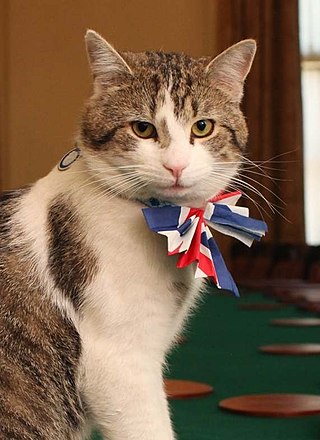
Larry is a British domestic tabby cat who has served as Chief Mouser to the Cabinet Office at 10 Downing Street since 2011. He is cared for by Downing Street staff and is not the personal property of the prime minister of the United Kingdom.

On 8 April 2013, former British prime minister Margaret Thatcher, Baroness Thatcher, died of a stroke at the Ritz Hotel, London, at the age of 87. On 17 April, she was honoured with a ceremonial funeral. Due to polarised opinions about her achievements and legacy, the reaction to her death was mixed across the UK, including contrasting praise, criticism, and celebrations of her life as well as celebrations of her death.

The Parliamentary Private Secretary to the Prime Minister is a Parliamentary Private Secretary serving the Prime Minister of the United Kingdom. The holder of the office is widely viewed as the Prime Minister's "eyes and ears" on the backbenches, serving as a liaison to the Prime Minister's parliamentary party. The Parliamentary Private Secretary is also responsible for meeting with members of Parliament when the Prime Minister is unavailable, and accompanying the Prime Minister to, and assisting them with preparations for Prime Minister's Questions. They usually sit directly behind the Prime Minister during question time.

Kenya–United Kingdom relations are bilateral relations between Kenya and the United Kingdom. The interactions between the two states have been positive and friendly since Kenya's independence in 1963. Both the UK and Kenya are members of the Commonwealth of Nations and engage with each other regularly on matters of military, economic and cultural importance. Kenya retains many aspects of British culture and governance, such as continuing to use English within administration, education and the law, driving on the left, hosting a diaspora community of Britons, and having a large Protestant population. The British military continues to play an important role in the country with Kenya hosting the UK's largest base in Africa, which provides vital anti-terrorism training to the Kenyan police. The British royal family, in particular Elizabeth II had very close personal ties to the country. Elizabeth II was in Kenya when she received news that her father King George VI had died, and had made multiple state visits throughout her reign. To mark the 2022 Platinum Jubilee, Prince Edward visited the country to reinforce ties and celebrate Kenya's historic and current relationship with the UK. British tourism and finance are significant contributors to the Kenyan economy, with 100,000 British people visiting the country ever year for its national parks and wildlife.

















